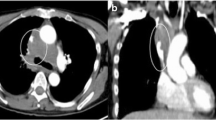Abstract
Purpose
To evaluate the clinical results of central venous access port (CV port) placement by translumbar inferior vena cava cannulation using angio-CT unit for cancer patients with superior vena cava syndrome.
Materials and methods
A CV port was placed by translumbar inferior vena cava cannulation using an angio-CT unit, in 14 consecutive patients. All patients had occlusion or advanced stenosis of the superior vena cava due to cancer progression.
Results
The technical success rate of the percutaneous translumbar CV port placement was 100%. The only complication related to port placement was bleeding in the right iliopsoas muscle seen on CT in one patient, but it stopped with conservative treatment. The mean initial device service interval was 125 days (range 6–448 days). Complications in the chronic phase occurred in two patients, one with catheter-related infection and the other with catheter breakage, for a rate of 0.44/1000 catheter days. In the patient with the broken catheter, the port chamber placement site was cut and replaced with a new catheter by guidewire exchange.
Conclusions
CV port placement with translumbar inferior vena cava cannulation using an angio-CT unit for cancer patients with superior vena cava syndrome was safe and effective.

Similar content being viewed by others
References
Craus W, Di Giacomo A, Tommasino U, Frezza A, Festa G, Cricri AM. Totally implantable central venous access: 15 years’ experience in a single unit. J Vasc Access. 2001;2(4):161–7.
Lund GB, Lieberman RP, Haire WD, Martin VA, Kessinger A, Armitage JO. Translumbar inferior vena cava catheters for long-term venous access. Radiology. 1990;174(1):31–5.
Bennett JD, Papadouris D, Rankin RN, McGloughlin RF, Kribs S, Kozak RI, et al. Percutaneous inferior vena caval approach for long-term central venous access. J Vasc Interv Radiol. 1997;8(5):851–5.
Rodriguez-Cruz E, Bonilla M, Perez J. Percutaneous translumbar inferior vena cava catheter placement for long-term hemodialysis treatment. Pediatr Nephrol. 2007;22(4):612–5.
Butros SR, Walker TG, Salazar GM, Kalva SP, Oklu R, Wicky S, et al. Direct translumbar inferior vena cava ports for long-term central venous access in patients with cancer. J Vasc Interv Radiol. 2014;25(4):556–60.
Sanal B, Nas OF, Dogan N, Korkmaz M, Hacikurt K, Yildiz A, et al. Safety and functionality of transhepatic hemodialysis catheters in chronic hemodialysis patients. Diagn Interv Radiol. 2016;22(6):560–5.
Azizkhan RG, Taylor LA, Jaques PF, Mauro MA, Lacey SR. Percutaneous translumbar and transhepatic inferior vena caval catheters for prolonged vascular access in children. J Pediatr Surg. 1992;27(2):165–9.
Wolosker N, Yazbek G, Munia MA, Zerati AE, Langer M, Nishinari K. Totally implantable femoral vein catheters in cancer patients. Eur J Surg Oncol J Eur Soc Surg Oncol Br Assoc Surg Oncol. 2004;30(7):771–5.
Merrer J, De Jonghe B, Golliot F, Lefrant JY, Raffy B, Barre E, et al. Complications of femoral and subclavian venous catheterization in critically ill patients: a randomized controlled trial. JAMA. 2001;286(6):700–7.
Heit JA, Silverstein MD, Mohr DN, Petterson TM, O’Fallon WM, Melton LJ 3rd. Risk factors for deep vein thrombosis and pulmonary embolism: a population-based case-control study. Arch Intern Med. 2000;160(6):809–15.
Tanaka T, Arai Y, Inaba Y, Inoue M, Nishiofuku H, Anai H, et al. Current role of hybrid CT/angiography system compared with C-arm cone beam CT for interventional oncology. Br J Radiol. 2014;87:20140126.
Silberzweig JE, Sacks D, Khorsandi AS, Bakal CW, Society of Interventional Radiology Technology Assessment C. Reporting standards for central venous access. J Vasc Interv Radiol. 2003;14(9 Pt 2):S443–52.
Kariya S, Tanigawa N, Kojima H, Komemushi A, Shomura Y, Ha-Kawa SK, et al. Percutaneous translumbar inferior vena cava cannulation under computed tomography guidance. Jpn J Radiol. 2009;27(4):176–9.
Thakor AS, Chung J, Patel R, Cormack R, Legiehn G, Klass D. The use of cone-beam CT in assisting percutaneous translumbar catheter placement into the inferior vena cava. Clin Radiol. 2015;70(1):21–4.
Tam A, Mohamed A, Pfister M, Rohm E, Wallace MJ. C-arm cone beam computed tomographic needle path overlay for fluoroscopic-guided placement of translumbar central venous catheters. Cardiovasc Interv Radiol. 2009;32(4):820–4.
Younes HK, Pettigrew CD, Anaya-Ayala JE, Soltes G, Saad WE, Davies MG, et al. Transhepatic hemodialysis catheters: functional outcome and comparison between early and late failure. J Vasc Interv Radiol. 2011;22(2):183–91.
Funding
All authors have no financial disclosure.
Author information
Authors and Affiliations
Corresponding author
Ethics declarations
Conflict of interest
All authors have no conflicts of interest.
Ethical approval
This retrospective study was approved by our institutional review board, and the requirement to obtain informed consent for inclusion in this study was waived.
Informed consent
Informed consent for the treatment was obtained from all patients before the procedure.
About this article
Cite this article
Kariya, S., Nakatani, M., Maruyama, T. et al. Central venous access port placement by translumbar approach using angio-CT unit in patients with superior vena cava syndrome. Jpn J Radiol 36, 450–455 (2018). https://doi.org/10.1007/s11604-018-0742-3
Received:
Accepted:
Published:
Issue Date:
DOI: https://doi.org/10.1007/s11604-018-0742-3




